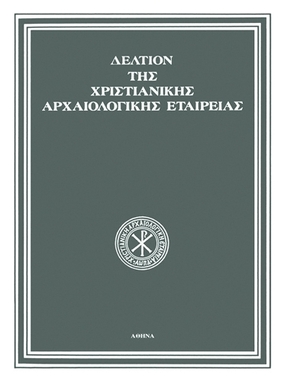Άγνωστο επιστύλιο του Θεοφάνη του Κρητός στη μονή Ιβήρων στο Άγιον Όρος
Part of : Δελτίον της Χριστιανικής Αρχαιολογικής Εταιρείας ; Vol.34, 1992, pages 185-208
Issue:
Pages:
185-208
Parallel Title:
An Unknown Iconostasis Beam by Theophanes the Cretan in the Iveron Monastery on Mount Athos
Section Title:
Articles
Abstract:
Preserved in the Iveron monastery on Mt. Athos arefour parts of an iconostasis beam with scenes from theChristological cycle. Once located in the funerarychurch, they are now kept with the monastery's collection of icons.These sections of the iconostasis beam range in lengthfrom 1.38 to 1.60 m. (1.38x0.46, 1.47x0.46, 1.49x 0.47and 1.60x0.465), and in height from 0.46 to 0.47 m.Each of the sections depicts three scenes, arranged asfollows: Last Supper, Washing of the Feet, Prayer onthe Mount of Olives, Betrayal of Judas, Judgment of theHigh Priests, Denial of Peter, Doubting Thomas, TheVisit of the Myrrh Bearers, Healing of the Lame Man,Mid-Pentecost, Christ and the Samaritan Woman,Healing of the Blind Man.Iconographically and stylistically, these subjects presentclose similarities with the work of Theophanes the Cretan, mainly as it is known from the wall-paintings of theAnapausa monastery (1527), of the katholikon and therefectory of the Stavronikita monastery (1546), andfrom the iconostasis beams of the monasteries of theGreat Lavra (1535) and Stavronikita (1546). More specifically, we can recognise in the Iveron iconostasisbeam basic characteristics of Theophanes' art such asthe simple, closed nature of the compositions, the geometric conception of the scene, the balanced and symmetrical distribution of piecemeal masses within a depiction, the tranquil rhythm of the complementaryposes and movements of figures (harmoniously incorporated and integrated in the composition), as well asthe exceptional spiritual ethos which mark the painter'sworks.This close relationship between the Iveron iconostasisbeam and Theophanes' works allows us to attribute theicons to his output. It should be noted that there is alsoan icon of Christ by Theophanes in the same monastery,and the attribution of the iconostasis beam not onlywidens our knowledge of artistic activity on Mt. Athos,but sets anew the problem of the painter's participationin the decoration of the monastery's katholikon.
Subject:
Subject (LC):




